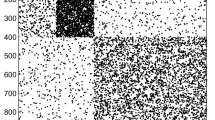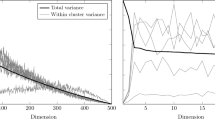Abstract
The statistical inference of stochastic block models as emerged as a mathematicaly principled method for identifying communities inside networks. Its objective is to find the node partition and the block-to-block adjacency matrix of maximum likelihood i.e. the one which has most probably generated the observed network. In practice, in the so-called microcanonical ensemble, it is frequently assumed that when comparing two models which have the same number and sizes of communities, the best one is the one of minimum entropy i.e. the one which can generate the less different networks. In this paper, we show that there are situations in which the minimum entropy model does not identify the most significant communities in terms of edge distribution, even though it generates the observed graph with a higher probability.
Access this chapter
Tax calculation will be finalised at checkout
Purchases are for personal use only
Similar content being viewed by others
References
Girvan, M., Newman, M.E.J.: Community structure in social and biological networks. Proc. Nat. Acad. Sci. 99(12), 7821–7826 (2002)
Fortunato, S., Hric, D.: Community detection in networks: a user guide. Phys. Rep. 659, 1–44 (2016)
Newman, M.E.J., Girvan, M.: Finding and evaluating community structure in networks. Phys. Rev. E 69(2), 026113 (2004)
Hastings, M.B.: Community detection as an inference problem. Phys. Rev. E 74(3), 035102 (2006)
Guimera, R., Sales-Pardo, M., Amaral, L.A.N.: Modularity from fluctuations in random graphs and complex networks. Phys. Rev. E 70(2), 025101 (2004)
Peixoto, T.P.: Nonparametric bayesian inference of the microcanonical stochastic block model. Phys. Rev. E 95(1), 012317 (2017)
Cimini, G., Squartini, T., Saracco, F., Garlaschelli, D., Gabrielli, A., Caldarelli, G.: The statistical physics of real-world networks. Nat. Rev. Phys. 1(1), 58 (2019)
Peixoto, T.P.: Entropy of stochastic blockmodel ensembles. Phys. Rev. E 85(5), 056122 (2012)
Peixoto, T.P.: Bayesian stochastic blockmodeling. arXiv preprint. http://arxiv.org/abs/1705.10225 (2017)
Fortunato, S., Barthelemy, M.: Resolution limit in community detection. Proc. Nat. Acad. Sci. 104(1), 36–41 (2007)
Peixoto, T.P.: Parsimonious module inference in large networks. Phys. Rev. Lett. 110(14), 148701 (2013)
Decelle, A., Krzakala, F., Moore, C., Zdeborová, L.: Inference and phase transitions in the detection of modules in sparse networks. Phys. Rev. Lett. 107(6), 065701 (2011)
Decelle, A., Krzakala, F., Moore, C., Zdeborová, L.: Asymptotic analysis of the stochastic block model for modular networks and its algorithmic applications. Phys. Rev. E 84(6), 066106 (2011)
Dandan, H., Ronhovde, P., Nussinov, Z.: Phase transitions in random Potts systems and the community detection problem: spin-glass type and dynamic perspectives. Philos. Mag. 92(4), 406–445 (2012)
Abbe, E., Sandon, C.: Community detection in general stochastic block models: fundamental limits and efficient algorithms for recovery. In: 2015 IEEE 56th Annual Symposium on Foundations of Computer Science, pp. 670–688. IEEE (2015)
Acknowledgments
This work was supported by the ACADEMICS grant of the IDEXLYON, project of the Université de Lyon, PIA operated by ANR-16-IDEX-0005, and of the project ANR-18-CE23-0004 (BITUNAM) of the French National Research Agency (ANR).
Author information
Authors and Affiliations
Corresponding author
Editor information
Editors and Affiliations
Rights and permissions
Copyright information
© 2020 Springer Nature Switzerland AG
About this paper
Cite this paper
Duvivier, L., Robardet, C., Cazabet, R. (2020). Minimum Entropy Stochastic Block Models Neglect Edge Distribution Heterogeneity. In: Cherifi, H., Gaito, S., Mendes, J., Moro, E., Rocha, L. (eds) Complex Networks and Their Applications VIII. COMPLEX NETWORKS 2019. Studies in Computational Intelligence, vol 881. Springer, Cham. https://doi.org/10.1007/978-3-030-36687-2_45
Download citation
DOI: https://doi.org/10.1007/978-3-030-36687-2_45
Published:
Publisher Name: Springer, Cham
Print ISBN: 978-3-030-36686-5
Online ISBN: 978-3-030-36687-2
eBook Packages: Intelligent Technologies and RoboticsIntelligent Technologies and Robotics (R0)




